On Sunday, December 7th, 1941, the Imperial Navy of Japan attacked the American Pacific Fleet at its base in Pearl Harbor, Hawaii. The devastating loss of life and carnage that morning not only surprised Americans, it also surprised and delighted Adolph Hitler. Hitler was shocked, not only that the Japanese had attempted it, but that it had been, in his mind, so “successful.”
Nazi Germany declared war on the United States four days later, and the very next day, on December 12th, Hitler picked up his phone and called Konteradmiral (Rear Admiral) Karl Dönitz (pictured below), Commander of Nazi Germany’s U-boat (submarine) fleet. Hitler ordered an immediate attack on the American homeland (by 1943 Dönitz would become Großadmiral or Grand Admiral of the Reich due to his strategic leadership of Nazi Germany’s naval warfare success).

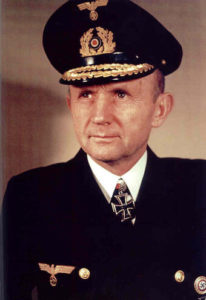
The fleet was stationed in the Port of Lorient (pictured below) on the west coast of Nazi occupied France, in the region of Brittany. Three massive submarine bunkers called K1, K2, and K3 were built in 1941 by Nazi Germany as part of the famous Atlantic Wall (an extensive system of defensive fortifications built all along coastal Europe) and would serve to protect up to thirty submarines from Allied aerial bombardment.



Admiral Dönitz quickly drew up a plan he called Unternehmen Paukenschlag or “Operation Drumbeat.” He would strike the American homeland as quickly as the rapid strike of a kettle drum. But to accomplish this, his U-boats would have to cross three thousand miles of ocean and still have enough fuel to patrol and attack targets along America’s East coast, the busiest and richest shipping lanes in the world. With some minor re-fitting to allow for extra fuel and torpedoes, his command determined that their Type IX (pictured below), long-range submarines could do it.
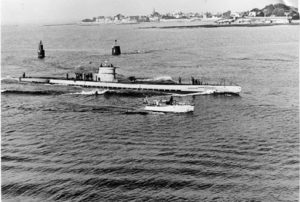
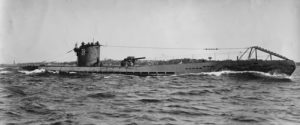
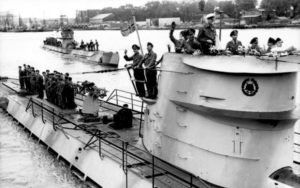
The first Type IX departed Lorient on December 18th, 1941, and others followed quickly after during the next few days. British Intelligence picked up their movement and transmissions and were able to plot their course across the Atlantic. The British alerted the Royal Canadian Navy and the U.S. Command of large concentrations of enemy submarines off of the North American coast, but the warnings were largely ignored. For America, the war was in Europe and the Pacific, and very far from home. We were completely unprepared for what was about to happen.
The plan of attack was simple; stay submerged during the day and surface at night to attack coastal shipping. Normally during wartime, coastal lights are dimmed or even blacked out to prevent enemy bombers from targeting cities, or in this case, to prevent enemy submarines from silhouetting ships against the coastal lights. So, when Korvettencapitan Reinhard Hardegen, commander of U-123 surfaced his vessel in January 1942, he was shocked. The entire American coast was lit up. Even merchant vessels sailing alone up and down the coast were lit like floating Christmas trees. It became a turkey shoot. Nazi U-boats all up and down the East coast began sinking ships at will and encountered little to no response from the enemy. Hardegen’s first patrol left Lorient on December 23rd, 1941, and reached the U.S. coast on January 12th, 1942. He proceeded to sink nine vessels totaling 53,170 tons. His second patrol which began in March of the same year sank ten vessels for a total of 57,170 tons. His submarine was only one of twenty-one U-boats hunting in American waters.
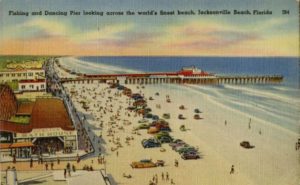


Hardegen recorded in his ship’s log that when he surfaced his vessel on a Friday night off of Jacksonville, FL (pictured above), he went out on deck and he and his men could hear music playing and people partying at the Jacksonville Pier. He also recorded seeing people on the beach in St. Augustine and noted the large black and white striped tower that was the St. Augustine Lighthouse. Eventually, U-boats were so confident that they would patrol in broad daylight since America’s fleet of sub-hunting destroyers was far away in the North Atlantic escorting convoys to help supply England’s fight against Germany.
Operation Drumbeat lasted until August of 1942. In all, 609 vessels were sunk sending 3.1 million tons of vitally needed supplies to the bottom of the ocean from Nova Scotia to the Gulf of Mexico. Twenty-four ships were sunk off the coast of Florida. Nearly 5,000 men, mostly Merchant Marines (civilian professional sailors) lost their lives. It would be the most successful attack by Nazi Germany against America during the entire war and very few people even knew it happened. The U.S. military, out of fear of widespread panic, did not publicize it.
In 1939 when England declared war on Germany following the Nazi invasion of Poland, U-boats operating in the English Channel and North Sea had the same experience. The U-boat crews referred to that attack as “The Happy Time.” Historian Michael Gannon has called Operation Drumbeat “America’s Second Pearl Harbor.” The U-boat crews called it simply, “The Second Happy Time.”
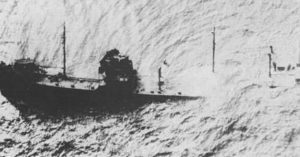
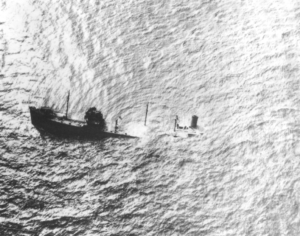
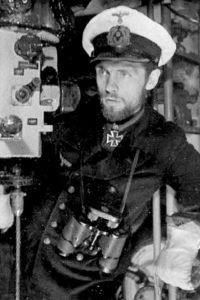
Above: The sinking of the SS Gulf America by U-123 five miles off Jacksonville, FL on April 11, 1942. 8,081 tons, length 445 feet, beam 64 feet, carrying 101,500 barrels of furnace oil. She had a crew of 48. Residents all up and down Florida’s First Coast, from Fernandina to St. Augustine, heard the explosion. Captain Hardegan is pictured far right.

